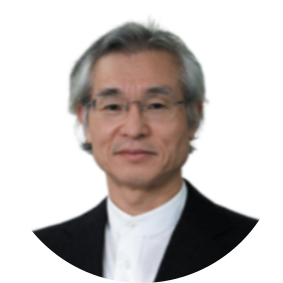
Xuemin (Sherman) Shen
University of Waterloo, Canada
Xuemin (Sherman) Shen is a University Professor in Electrical and Computer Engineering at the University of Waterloo, Canada. His research interests include user mobility and network resource management, wireless network security, for future communication systems. Professor Shen is the Technical Program Committee Chair for IEEE Globecom'24, Globecom'16, IEEE Infocom14, IEEE VTC’10 Fall, and IEEE Globecom'07. He was the Editor-in-Chief of the IEEE Internet of Things Journal, IEEE Network, and IET Communications. Professor Shen served as the 2022-2023 President of IEEE Communications Society. He is a Fellow of the IEEE, Royal Society of Canada, Canadian Academy of Engineering, and Engineering Institute of Canada, a Foreign Member of Chinese Academy of Engineering, and an International Fellow of the Engineering Academy of Japan
Speech Title: Holistic Network Virtualization: AI-Native 6G
Abstract: With the commercialization of 5G communication networks, the global telecommunication community has shifted its focus to R&D for 6G networks. To support disruptive new applications along with growing service demands, it is envisioned that 6G will require agile network architectures in the presence of network dynamics, intelligent network management to address complexity due to extreme connectivity, and customized service provision to meet diverse service requirements. In this presentation, we will discuss potential ideas and solutions towards intelligent network architectures and flexible network management. First, we will briefly introduce network slicing and digital twin, and present how network slicing and digital twin can support flexible network management, taking advantage of advances in artificial intelligence. Then, we will focus on potential realization of intelligent network architectures, followed by our recent work on digital twin empowered resource allocation for collaborative sensing as a case study.

Geoffrey Li
Imperial College London, UK
Geoffrey Ye Li, FREng (Fellow of Royal Academic of Engineering) and Fellow of IEEE, is a Chair Professor at Imperial College London, UK. Before joining Imperial in 2020, he was a Professor at Georgia Institute of Technology, USA, for 20 years and a Principal Technical Staff Member with AT&T Labs – Research (previous Bell Labs), USA, for five years. He introduced deep learning to communications several years ago, which has become a popular research area now. He made fundamental contributions to orthogonal frequency division multiplexing (OFDM) for wireless communications, which made him win 2024 IEEE Eric E. Sumner Technical-Field Award. He also won several awards from IEEE Signal Processing, Vehicular Technology, and Communications Societies, including 2019 IEEE ComSoc Edwin Howard Armstrong Achievement Award.
Speech Title: Fast Adaptation for Deep Learning based Wireless Communications
Abstract: The integration with artificial intelligence (AI), especially deep learning (DL), is recognized as one of the six usage scenarios in next-generation wireless communication. In this talk, we first provide a brief overview on DL for wireless communications in the past around 10 years and present several critical challenges hinder the widespread applications of DL techniques in wireless communications. Since the existing DL-based wireless communications struggle to address the dynamic environments, we then discuss fast adaptation for DL-based wireless communications by using the few-shot learning (FSL) techniques. After identifying the difference between fast adaptation in wireless communications and traditional AI tasks, we outline two design requirements for applying FSL techniques to wireless communications and provide a comprehensive discussion on FSL techniques in wireless communications that satisfy these two design requirements. In particular, we emphasize the crucial role of domain knowledge in achieving fast adaptation. At the end of this talk, we highlight several open issues for future research.

Sumei Sun
Institute for Infocomm Research (I2R), Agency for Science, Technology and Research (A*STAR), Singapore
Dr Sumei Sun is the Executive Director of the Institute for Infocomm Research (I2R), A*STAR, Singapore. A*STAR I2R focuses on multi-disciplinary digital technologies research including artificial intelligence (AI), communications and connectivity, and cyber security. Sumei’s current research interests include next-generation wireless communications, cognitive communications and networks, communications-computing-control integrative design, applied AI, industrial internet of things, and signal intelligence. She also holds a joint appointment with the Singapore Institute of Technology, and an adjunct appointment with the National University of Singapore, both as a full professor.
With strong passion in industry-relevant research and technology creation, Sumei has authored and co-authored more than 300 technical papers and received three best paper awards. She is the inventor/co-inventor of over thirty patented technologies, with most of them licensed to industries. She’s a Fellow of the IEEE and Fellow of the Academy of Engineering Singapore, and recipient of the 2023 IEEE VTS Women’s Distinguished Career Award and Singapore National Day 2022 Public Administration Medal (Bronze)
Speech Title: Integrated Sensing, AI, and 6G: Opportunities and Challenges
Abstract: The IMT-2030 Vision’s four overarching aspects, namely, sustainability, ubiquitous intelligence, security/privacy/resilience, and connecting the unconnected, act as essential design principles applicable to all usage scenarios. Ubiquitous intelligence, in particular, will on one hand be empowered by 6G and beyond, on the other hand will also transform the design of 6G systems and networks.
In this talk, we will discuss the native integration of AI and sensing in 6G systems and networks, the potential opportunities and performance gains and the design challenges. We will share a few examples in our endeavour and motivate further research.

Meixia Tao
Shanghai Jiao Tong University, China
Meixia Tao is a Professor in the Department of Electronic Engineering at Shanghai Jiao Tong University, China. Her current research interests include wireless edge learning, semantic communications, integrated communication-computing-sensing, MIMO beamforming, and channel modeling. She has published over 120 journal papers and 140 conference papers. She has received several awards and recognitions, including the 2020 First Prize in Natural Science from the Shanghai Municipality, the 2019 IEEE Marconi Prize Paper Award, and the 2013 IEEE Heinrich Hertz Award for Best Communications Letters. Dr. Tao is currently a Vice-Chair of the Information Theory Society of the Chinese Institute of Electronics. She is a Fellow of IEEE and receives the National Science Fund for Distinguished Young Scholars.
Speech Title: Learning-based Coding and Transmission for Semantic Communications
Abstract: As a new communication paradigm beyond Shannon, semantic communication (SemCom) can significantly reduce the required communication bandwidth and enhance downstream task performance by extracting and transmitting information directly relevant to the receiver's tasks. SemCom is envisioned to have transformative potential in 6G, facilitating a wide range of intelligent services, such as metaverse, smart surveillance, intelligent transportation, and robotic collaboration. In this talk, I will first provide an overview of the deep-learning-enabled SemCom framework. Then I will highlight the main design challenges of SemCom in terms of environmental adaptability, digital compatibility, and performance stability towards practical implementation. After that, I will share our latest research progress on the design of semantic coding and transmission to address these challenges, and also provide some insights for future investigation.

Fumiyuki Adachi
Tohoku University, Japan
Fumiyuki Adachi received the B.S. and Dr. Eng. degrees in electrical engineering from Tohoku University, Sendai, Japan, in 1973 and 1984, respectively. In April 1973, he joined the Electrical Communications Laboratories of NTT and started mobile communications research. From July 1992 to December 1999, he was with NTT DOCOMO, leading a research group on wideband/broadband wireless access for 3G and beyond. He contributed to developing the 3G air interface standard, known as W-CDMA. Since January 2000, he has been with Tohoku University, Sendai, Japan. Currently, he is researching resilient wireless communication technology to realize beyond 5G/6G systems as a Specially Appointed Research Fellow/Professor Emeritus at the International Research Institute of Disaster Science (IRIDeS), Tohoku University. His research interests are in the areas of wireless signal processing and networking, including multi-access, equalization, antenna diversity, cooperative transmission, channel coding, and radio resource management. He is IEEE Life Fellow and IEICE Life Fellow. He is the recipient of 2000 IEEE VTS Avant Garde Award, 2002 IEICE Achievement Award, 2004 Thomson Scientific Research Front Award, 2010 Prime Minister Invention Award, 2014 C&C Prize, 2017 IEEE VTS Stuart Meyer Memorial Award, and 2017 IEEE ComSoc RCC Technical Recognition Awar
Speech Title: User-centric distributed massive MIMO for the ultimate cellular communication system
Abstract: As the high data rate communication services proliferate in mobile communications, there is a demand for very high peak data rates in excess of Gbps is demanded, while the available radio bandwidth is limited. To achieve this goal, we need to improve the spectrum efficiency further and expand the transmission bandwidth. In 5G systems, the mmWave band has been allocated. However, mmWave signals have high pathloss and rectilinear propagation characteristics, resulting in short communication distances and frequent blockages caused by obstacles such as buildings. The utilization of distributed massive MIMO, also known as a cell-free system, is an effective approach to significantly improve spectrum efficiency. This approach turns the disadvantages of the mmWave band into advantages. User-centric ultra-small virtual cells or user-clusters are formed based on user location information, realizing the ultimate cellular system. The same frequencies are reused in all user-clusters. The small-scale multiuser distributed MIMO with interference suppression is simultaneously performed in all user-clusters. In this presentation, we will discuss the system architecture of a user-centric distributed massive MIMO system and share recent performance evaluation results.

Honggang Zhang
Zhejiang University, China
Honggang Zhang (Fellow, IEEE) is the Chief Managing Editor of Intelligent Computing, a Science Partner Journal (SPJ), as well as a Professor with the College of Information Science and Electronic Engineering, Zhejiang University, Hangzhou, China. He was an Honorary Visiting Professor with the University of York, York, U.K., and an International Chair Professor of Excellence with the Université Européenne de Bretagne and Supélec, France. He has coauthored and edited two books: Cognitive Communications: Distributed Artificial Intelligence (DAI), Regulatory Policy & Economics, Implementation (Wiley) and Green Communications: Theoretical Fundamentals, Algorithms and Applications (CRC Press). His research interests include cognitive radio and networks, green communications, machine learning, artificial intelligence, semantic communications, mobile computing, and the Internet of Intelligence (IoI). He is a co-recipient of the 2021 IEEE Communications Society Outstanding Paper Award and the 2021 IEEE Internet of Things Journal Best Paper Award. He was the leading Guest Editor for the Special Issues on Green Communications of the IEEE Communications Magazine. He served as a Series Editor for the IEEE Communications Magazine (Green Communications and Computing Networks Series) from 2015 to 2018 and the Chair of the Technical Committee on Cognitive Networks of the IEEE Communications Society from 2011 to 2012. He is the Associate Editor-in-Chief of China Communications.
Speech Title: Wireless LLM Inference within the Framework of AI-Native NetGPT
Abstract: Large language models (LLMs) have triggered tremendous success to empower information generation and inference. Towards personalized generative inference, a collaborative cloud-edge-terminal methodology is promising, as it facilitates the effective orchestration of heterogeneous distributed communication and computing resources.
Recently, we have put forward NetGPT (Network-enabled Generative Pre-Trained Transformer), to capably synergize appropriate LLMs at the edge, user equipment (UE), and cloud based on their different computing capacities. Edge and terminal LLMs could efficiently leverage location-based information for personalized prompt completion, thus benefiting the interaction with the cloud LLM.
Also, this talk will highlight the essential changes required for an artificial intelligence (AI)-native network architecture towards NetGPT, with emphasis on deeper integration of communications and computing resources and careful calibration of logical AI workflow.
Furthermore, toward efficient wireless LLM inference in edge computing, this talk will analyze the impact of different splitting points in mainstream open-source LLMs. On this basis, this talk introduces a framework taking inspiration from model-based reinforcement learning (MBRL) to determine the optimal splitting point across the edge and user equipment. By incorporating a reward surrogate model, the proposed approach significantly reduces the computational cost of frequent performance evaluations. Extensive simulations demonstrate that this method effectively balances inference performance and computational load under varying radio accessing conditions, providing a robust solution for LLM deployment in decentralized settings.

Jianhua Zhang
Beijing University of Posts and Telecommunications, China
Jianhua Zhang, a professor at Beijing University of Posts and Telecommunications and Fellow of China Institute of Communications. She is currently the Deputy Dean of the School of Science at BUPT, director of the Joint Innovation Center of Beijing University of Posts and Telecommunications and China Mobile Research Institute, a deputy of the 16th People's Congress of Beijing, an associate of China Institute of Communications, a member of the CCSA Council, the leader of the China’s IMT-2030 (6G) Channel Measurement and Modelling Working Group and the deputy leader of the Frequency Sub-group, and the deputy head of the Frequency Sub-group of the IMT-2020 (5G) Promotion Group, and IEEE ComSoc Channel Modeling subgroup. Her research fields cover broadband mobile communication channel modeling theory and transmission technology. She has won the second prize of the National Technological Invention Award twice, the 18th China Young Women Scientist Award, the First Prize of the Institute of Communication for Technical Invention, the First Prize of Institute of Electronics for Science and Technology, the First Prize of Institute of Radio Management for Science and Technology, Mao Yisheng Youth Science and Technology Award, the Outstanding Science and Technology Worker of the Institute of Electronics, Excellent Young Expert Award from Engineering, Distinguished Corresponding Expert Award from Frontiers of Information Technology & Electronic Engineering, Top 2% Scientists on Stanford Award, and was funded by the National Science Fund for Distinguished Young Scholars, "Gold Medal" at the International Exhibition of Inventions, Geneva, the Science Fund for Outstanding Young Scholars, the New Century Excellent Talents of the Ministry of Education and the Excellent Undergraduate Education Team Award in Beijing.
Speech Title: 6G Channel Research Recent Progress: Modeling, Prediction and Digital Twin
Abstract: With the global commercialization of fifth-generation (5G) communication, research and standardization of sixth-generation (6G) technology have been undertaken worldwide. Channel research is a prerequisite for evaluating and optimizing 6G technology. This report presents research on channel measurement, modeling, prediction and digital twin for 6G. Firstly, it summarizes the significance and trends of 6G channel research, focusing on the discussion of 6G requirements and the challenges that 6G enabling technology poses to channel measurement and modeling. To address these challenges, the report introduces the latest research progress of our group in terms of channel measurement, modeling and simulation on RIS, Massive MIMO, and ISAC, among others. Then, some recent advances on 6G channel predication and digital twin are presented. Finally, open issues for future research are discussed to provide insights into 6G channel research.